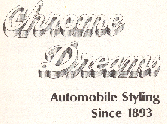
A History of Scholarship on American Automobile Design
Auto Design as Mass Culture, Influenced by Societal Change
There were, however, several scholarly works that conceived of auto design not as high art but as part of a mass culture that changed and evolved with the social conflicts and contradictions of America. The first such analysis to appear was a rather modest, unassuming work issued by an automotive publisher, Paul Wilson’s Chrome Dreams: Auto Styling Since 1893 (1979). Unlike most works on auto design, which are lavishly illustrated, coffee-table books, Wilson’s contribution was focused on historical narrative, and included only unspectacular line drawings of cars. But what it lacked in flashiness, it made up for with a well-researched, chronological account of American auto styling from the beginning to about 1970. From the outset, Wilson recognized that auto design is a popular art, which expresses the public taste and culture of the period that produces it. So he ignored individuals stylists and concentrated on the changing public as the real creator of the look of cars in an era. He placed early auto design in the context of the rising aspirations of middle- and working-class Americans for symbols of success. And the streamlined cars of the Depression were said to reflect the need of the masses for signs of progress in this dismal decade. But Wilson tended to fall into simple psychologism in his explanation of the cars of the fifties as reflective of the “subconscious emotions” of aggression and sexuality. Nonetheless, his more social approach was a refreshing departure from the usual emphasis on heroic designers.
Published in the same year as Wilson’s book was a more sophisticated scholarly analysis that also conceived of design as part of an evolving culture of mass consumption in American society. Jeffrey Meikle’s Twentieth Century Limited (1979) did not focus exclusively on autos but traced the rise of the entire profession of industrial design in the United States in the crucial years between 1925 and 1939. But his holistic approach yielded more insights on autos than most books dealing exclusively with them. Meikle placed the emergence of aesthetically designed industrial products, including cars, in the social context of an America struggling to come to grips with the disturbing consequences of the new technology of mass production. During the Great Depression, for example, he argued that the streamlined look of cars and other consumer goods resulted from a complex combination of the corporate need to stimulate demand with the consumer desire for technological progress that was orderly and harmonious. Thus, Meikle showed that social, economic, and psychological factors converged to produce the aesthetics of products. There was no room in his complex cultural analysis for either one-sided corporate manipulation of consumers or simplistic psychologism that attributes design to hidden desires like sex and power.
Carrying Meikle’s type of sophisticated social analysis into the all-important postwar period was a delightful but learned book by design journalist Thomas Hine entitled Populuxe (1986). The author coined the title’s term to describe the style of popular luxury that dominated not merely automobiles but also other mass-produced goods like appliances, housewares, and architecture in America between 1954 and 1964. In an analysis that would be envied of any sociologist, Hine argued that the exuberant and often futuristic style that reigned in this period was produced not by individual needs but by a social mood that gripped the country. And he carefully tied this mood to social trends like equalization of income, suburbanization of the working class, the decline of extended families, and the insecurities of the Cold War. His chapter on automobile design in particular bristles with insights on the connections of tail fins and toothy, bomb-laden grilles to wartime aviation, space flight, McCarthyism, and social mobility. Hine carries all this off with a serious and critical attitude that avoids both the heroic worship of Armi and the condescending cuteness of Bayley. These works by Meikle and Hine are models of how to do serious scholarship that gives popular design its due and does not seek to force it into the inappropriate framework of the high arts.
This is the model that I tried to follow in my own book on American automobile design, Auto Opium: A Social History of American Automobile Design (1994). Unlike either Meikle or Hine, however, my analysis focused on the social conflicts and struggles that shaped auto design throughout its history. I argued that the design of cars was an unconscious attempt to solve in the realm of culture the conflicts and contradictions created by the rise of the system of mass production, for which the auto industry was also largely responsible. The analysis showed that the look of cars was indeed shaped by the needs and desires of consumers, but that these were themselves of the social products an unequal and debilitating production system. Unable to realize their needs for individuality, sociality, and autonomy in the realm of work, many working Americans turned to the realm of consumption for compensation. These rechanneled desires inevitably shaped the work of car designers, who were forced by marketplace competition to give consumers the compensation they demanded.
My book was not, of course, the last word on auto design. There are still many unexplored problems and questions that demand the attention of serious scholars. Contrary to the predictions of some scholars that computers and other microelectronic devices would become the new focus of consumer culture, the automobile has continued to be the prime mover of the economy and to occupy a privileged place in the psyche of consumers. Consequently, the design of these mobile extensions of ourselves will occupy scholars for decades to come.
<<Previous Section - Next Section>>
Introduction
Scholarly Inattention to Auto Design
Emergence of a Critical Popular Literature
1950s Scholarship on Design
The Postmodern Validation of Auto Design as Art
Auto Design as Mass Culture, Influenced by Societal Change
Annotated Bibliography
Complete Text Printable View
©2004 Automobile in American Life and Society






